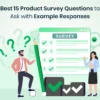Understanding a customer’s perceptions about a product can make or break a business. Gathering meaningful feedback helps businesses identify what customers like, what they dislike, and what they expect next. This entire process is possible with a Product Survey which is the most effective way to collect feedback systematically and transform it into actionable insights.
A well-designed product survey’s objective is to gather specific and valuable feedback that directly impacts product improvement. Ultimately, businesses will be able to identify their strengths and weaknesses that spike retention rates contributing to sustained revenue growth.
Product Survey for Business Success
Every business tends to develop products to retain old customers and attract new ones. This can be achieved with an effective feedback mechanism and Product Survey Questions play a crucial role here in giving a clear view of customers’ expectations. Accordingly, timing matters and asking the right questions at the right time can extract desired results for businesses.
Questions must be carefully crafted to avoid bias and extract truthful responses. Neutral wording is important to avoid leading respondents, and logic branching can be used to ask follow-up questions that are relevant to the respondent.
Prototyping and testing the survey with a small group of customers can help refine the language and ensure that it resonates with different demographics. When these questions are added to the customer journey, they capture real-time feedback and track how perceptions change over time, guiding future product roadmaps.
Types of Product Survey Questions
Effective surveys require different question types to achieve their goals through the combination of open-ended questions, multiple-choice options, rating scales, and Likert scales. The combination of different formats allows you to collect both qualitative and quantitative information. Open-ended questions provide customer feelings, yet rating questions measure their satisfaction levels. The use of structured product experience survey questions helps you obtain detailed information about usability, design, and value perception. This leads to better product strategy and development cycles.
Designing an Effective Product Survey
It is vital to identify the goals of a survey before drafting questions. Deciding whether to improve usability, measure customer loyalty, or test new product features is the very first step in setting survey objectives. The objective determines what to ask. The questions in Product Survey examples need to be concise and direct because this will lead to more accurate and meaningful responses from the target audience.
The Top 15 Product Survey Questions with Examples
The following are 15 essential product survey questions, each with a scenario and rationale for each response. These are designed to be versatile across industries, balancing closed and open formats to provide rich insights.
1. How often do you use our product?
This question helps determine product adoption and engagement levels. For instance:
Example: How frequently do you use our product?
- Daily
- Weekly
- Monthly
- Rarely
2.How satisfied are you with our product overall? (Scale: 1-5)
Example: A user rates 4/5 with some technical glitches
3. What do you like most about the product?
This is an open-ended question, and focuses on the product’s strongest aspect, which could be a feature. The responses here help the marketing teams to prioritize the features that customers appreciate.
4. How easy is it to use our product? (Scale: Very Easy to Very Difficult)
Example: A response like ‘Very Easy’ suggests a feature like intuitive dashboards.
5. What do you like least about our product? (Open-ended)
Example: Mobile interface and responsiveness could improve.
6. Does the product meet your expectations? (Open-ended Question)
Example: If a user’s response is ‘NO,’ the product should be reassessed.
7. How likely are you to recommend our product to others? (NPS Question)
Example: This question measures loyalty and advocacy, making it easy to track and improve key metrics in your product experience survey questions.
8. How does our product compare to competitors?
Example: This is a comparative question used in competitor analysis to gauge the product with its competitors and where it stands in the market.
9. Have you experienced any issues or bugs while using our product? (Closed-ended Question)
Example: This question identifies defects that customers encounter while using the product and is mostly used in customer support, quality assurance, or product improvement surveys to detect malfunctions.
10. What is the primary reason for choosing our product? (Close-ended Question)
Example: This question aims to find out the main factor behind a customer’s choice to opt for a particular product. The factors could be price, quality, feature, or brand’s reputation in the market.
11. What primary problem does our product solve for you (customer)? (Open-ended Question)
Example: This question focuses on the core value the product provides from a customer’s experience. It can offer qualitative data that can help businesses understand customers’ perspectives.
12. What improvements would you suggest for our product? (Open-ended Questions)
Example: This question encourages respondents to share ideas and actionable suggestions for enhancing the product.
13. How would you rate our customer support related to this product? (Scale: 1-5)
Example: This question falls under customer service satisfaction and focuses on professionalism and resolution effectiveness.
14. How could we better meet your needs with future updates? (Open-ended Question)
Example: This question emphasizes gathering feedback about customers’ expectations on product improvement. It encourages customers to suggest specific changes like adding new features or enhancements.
15. On a scale of 1–10, how likely are you to continue using our product? (Closed-ended Question)
Example: It provides quantitative data that businesses use to predict customer retention, assess customer loyalty, and identify customers who may want to exit.
Analyzing and Acting on Feedback
The true value of a product survey really depends on how thoroughly you examine the results. Tools like piHappiness can make this process much simpler. They offer analytics dashboards that clearly show customer satisfaction trends, NPS scores, and which features customers prefer most. This really helps your team quickly turn feedback into tangible improvements.
piHappiness is a good option for businesses today to manage feedback and survey software. You can set up, send out, and look at survey results without a lot of hassle. They work across different places too, like websites, email, in your app, or even text messages. With automated features and AI insights, piHappiness helps businesses spot new trends, figure out what makes customers happy, and generally make their customer experience better.
Conclusion
Understanding how customers’ sentiment is really important for creating products. When you ask the right Product Survey questions, you can find out what customers care about, where they struggle, and how they think of product performance. Combining actionable questions with a robust feedback system, like piHappiness, helps businesses make product changes based on real data. This can lead to happier users and a stronger connection to your brand.
Ask the right questions, pay close attention to their responses, and make clear decisions. This is the foundation of every successful product journey.








